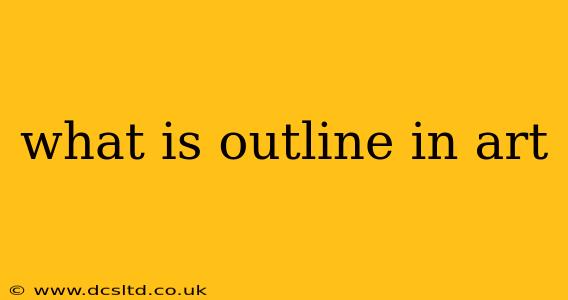The outline, seemingly simple, is a fundamental element in art. It's more than just a line; it's a powerful tool that defines shapes, creates depth, and influences the overall mood and style of a piece. This comprehensive guide will explore the multifaceted nature of outlines in art, addressing common questions and misconceptions.
What is an Outline in Art?
In its simplest form, an outline is a line that defines the edge or contour of a shape or form. It acts as a boundary, separating the subject from its background. However, its role transcends mere delineation; it contributes significantly to the artwork's visual impact and meaning. The character of the outline – its thickness, color, and style – can drastically change the overall feeling of the artwork.
What are the Different Types of Outlines?
Outlines aren't monolithic; they vary greatly in style and execution. Here are some common types:
-
Bold Outlines: These thick, prominent lines create a strong sense of definition and often a graphic, almost cartoonish effect. They're frequently used in graphic design, illustration, and children's book illustrations.
-
Thin Outlines: Delicate, subtle lines offer a more refined and less obtrusive definition. They can be used to suggest form without overwhelming the overall composition. They're often seen in detailed drawings and realistic renderings.
-
Dashed Outlines: These interrupted lines create a sense of movement, fragility, or incompleteness. They can be used to suggest transparency or to add visual interest to a drawing.
-
Implied Outlines: These aren't actual lines but are created by the juxtaposition of shapes and colors. The viewer's eye perceives the boundary even without a distinct line. This technique is frequently employed in abstract and minimalist art.
-
Varied Outlines: This technique involves using lines of different thicknesses and styles within the same artwork. It adds visual interest and can be used to highlight certain areas or create a sense of depth.
How is Outline Used in Different Art Styles?
The use of outlines varies significantly across art styles:
-
Cartooning and Illustration: Bold outlines are a staple, providing clear definition and a sense of energy.
-
Realism: Outlines are often minimized or implied, allowing subtle gradations of light and shadow to define form.
-
Abstract Art: Outlines can be used minimally or completely abandoned, allowing the focus to fall on color, texture, and composition.
-
Line Art: The outline is the primary element, defining the entire image. This style prioritizes line weight, variation, and composition to create the artwork.
Does the presence of outlines always mean the artwork is 'less sophisticated'?
This is a common misconception. The sophistication of an artwork isn't determined by the presence or absence of outlines. Many highly sophisticated works, across diverse art historical periods and movements, effectively utilize outlines to achieve their artistic goals. The choice to include or omit outlines is a stylistic one, dependent on the artist's vision and the desired effect.
How can I improve my use of outlines in my art?
Experimentation is key. Try using different line weights, colors, and styles to see how they affect your artwork. Observe how professional artists utilize outlines in their work to learn from their techniques.
What are the benefits of using outlines in art?
- Clear definition of shapes: Outlines provide a clear boundary, separating forms and making them easily discernible.
- Visual interest: The character of the outline itself can add visual interest and texture to the artwork.
- Emphasis and focus: Bold outlines can draw attention to specific areas of the artwork.
- Stylistic expression: The choice of outline contributes significantly to the overall style and mood of the artwork.
By understanding the versatile role of outlines, artists can harness their power to enhance their creative expressions and achieve a greater level of control over their artwork. It's a foundational element with surprising depth and potential.
